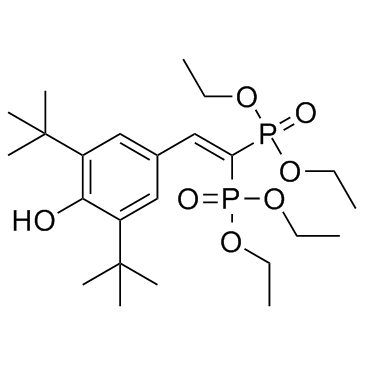The novel cholesterol-lowering drug SR-12813 inhibits cholesterol synthesis via an increased degradation of 3-hydroxy-3-methylglutaryl-coenzyme A reductase.
T A Berkhout, H M Simon, D D Patel, C Bentzen, E Niesor, B Jackson, K E Suckling
Index: J. Biol. Chem. 271 , 14376-14382, (1996)
Full Text: HTML
Abstract
SR-12813 (tetra-ethyl 2-(3,5-di-tert-butyl-4-hydroxyphenyl)ethenyl-1, 1-bisphosphonate) lowers plasma cholesterol in five species. In this paper we investigate the underlying mechanism using Hep G2 cells. SR-12813 inhibited incorporation of tritiated water into cholesterol with an IC50 of 1.2 microM but had no effect on fatty acid synthesis. Furthermore, SR-12813 reduced cellular 3-hydroxy-3-methylglutaryl-coenzyme A (HMG-CoA) reductase activity with an IC50 of 0.85 microM. The inhibition of HMG-CoA reductase activity was rapid with a T1/2 of 10 min. After a 16-h incubation with SR-12813, mRNA levels of HMG-CoA reductase and low density lipoprotein (LDL) receptor were increased. The increased expression of LDL receptor translated into a higher LDL uptake, which can explain the primary hypocholesterolemic effect of SR-12813 in vivo. Western blot analysis indicated that the amount of HMG-CoA reductase protein rapidly decreased in the presence of SR-12813. Pulse-chase experiments with [35S]methionine showed that the T1/2 of HMG-CoA reductase degradation decreased in the presence of SR-12813 from 90 to 20 min. Pre-incubation with 50 microM of lovastatin did not prevent the effects of SR-12813 on HMG-CoA reductase degradation, indicating that the compound does not need mevalonate-derived regulators for its action. It is concluded that SR-12813 inhibits cholesterol synthesis mainly by an enhanced degradation of HMG-CoA reductase.
Related Compounds
| Structure | Name/CAS No. | Molecular Formula | Articles |
|---|---|---|---|
 |
SR-12813
CAS:126411-39-0 |
C24H42O7P2 |
|
Dehydroepiandrosterone induces human CYP2B6 through the cons...
2007-09-01 [Drug Metab. Dispos. 35 , 1495-501, (2007)] |
|
Cyclin-dependent kinase 2 negatively regulates human pregnan...
2008-11-07 [J. Biol. Chem. 283 , 30650-7, (2008)] |
|
Isolation of mutant cells lacking Insig-1 through selection ...
2004-10-08 [J. Biol. Chem. 279 , 43136-47, (2004)] |